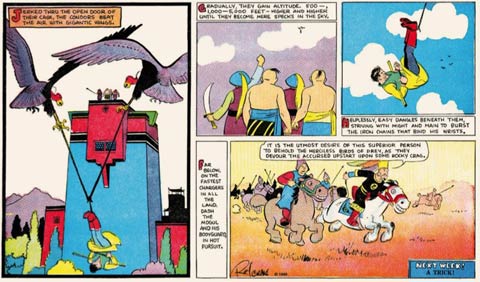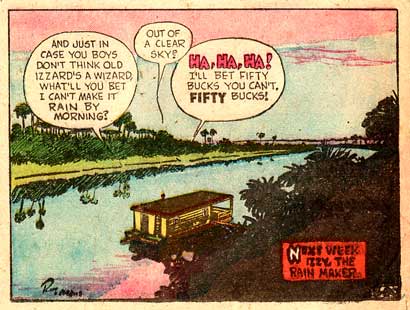'Buz Sawyer' (1945).
Roy Crane is one of the classic artists of American newspaper comics, and the creator of the pioneering adventure feature 'Wash Tubbs and Captain Easy' and 'Buz Sawyer'. Royston Campbell Crane was born in 1901 in Adilene and raised in Sweetwater, Texas, as the son of a lawyer and a former schoolteacher. The young Crane showed an early interest in drawing and cartoons, and while in high school, he took a correspondence course in cartooning from the Landon School. Later on, he studied at the Chicago Academy of Fine Arts, where he met fellow cartoonists Carl Ed and Leslie Turner, and at the University of Texas.
'Buz Sawyer'.
However, Crane didn't graduate and he spent the early 1920s traveling across the American South West, living the hobo life, and eventually went to sea on a tramp steamer to Europe. In 1922 he settled in New York, got a job with the New York World, owned by Joseph Pulitzer, and became the assistant of H.T. Webster. He also sold gag cartoons to Judge magazine and by 1924 he drew his first, though unsuccessful, syndicated cartoon panel, 'Music to the Ear', for United Features.
'Captain Easy' (1 October 1933).
The comic strip that made him famous, 'Wash Tubbs', first appeared on 21 April 1924. The early 'Wash Tubbs' strips were daily gags, syndicated by NEA Syndicate in Cleveland. But Crane's love of adventure, traveling and the railways eventually turned this strip into one of the first adventure comic strips. An adventurer himself, Crane spent several weeks in a circus during 1927 and traveled to Mexico and Cuba, Crane used his own experiences for his comic strip hero.
It was in 1929 when Crane introduced the heroic character 'Captain Easy' in his comic. Between 1931 and 1933 he made an ill-fated attempt at a 'Wash Tubbs' Sunday page. Crane's comic was already widely imitated by 1933, when he came up with his pinnacle of virtuosity and verve, the Sunday page of 'Captain Easy - Soldier of Fortune'. Crane was not only an innovator in his storylines and artwork, but also in his inventive use of onomatopoeic sound effects.
'Buz Sawyer' (1948).
In 1943, tired of the restrictions of his syndicate, Crane left 'Wash Tubbs' to his assistant Leslie Turner and launched a new strip with King Features Syndicate, which let him own all the rights. This was 'Buz Sawyer', a wartime comic about a Navy aviator, that started on 1 November 1943. Like in his previous comic, Crane showed a talent for innovation, this time experimenting with illustrative shading techniques. After World War II, Sawyer became a civilian, until he rejoined the Navy in the 1950s and flew over Vietnam during the 1960s.
It ran for over forty years and won many honors and awards. Crane also added a Sunday page, which focused on the more rural adventures of Sawyer's pal Roscoe Sweeney. Over the years, Crane has worked with several assistants. Ed Granberry took up the scriptwriting of the strip in the 1940s, Henry Schlensker assisted on the dailies from 1946, while Clark Haas did drawing chores on the Sunday page from the late 1940s.
'Captain Easy' (1941).
Due to an ulcer condition, Crane was forced to retire from the strip in the 1960s, but it was continued by his assistants Granberry and Schlensker, with whom he kept in close contact. The Sunday page came to an end in 1974, by then drawn by Al Wenzel. Roy Crane died in 1977. His famous comic strip was continued by his assistants until 1983, and then taken over by John Celardo until 1989.
On 6 October 1965, Crane was also one of six cartoonists (the others being Milton Caniff, Bill Mauldin, Don Sherwood, Mort Walker and George Wunder) to be invited by U.S President Lyndon B. Johnson to the White House as "creators of military comics."
Roy Crane was an influence on Jerry Dumas, Will Elder, Jules Feiffer, Martin Landau, Rick Parker, Jim Scancarelli, John Severin, Dan Spiegle, Joost Swarte and George Ward.
Roy Crane.







